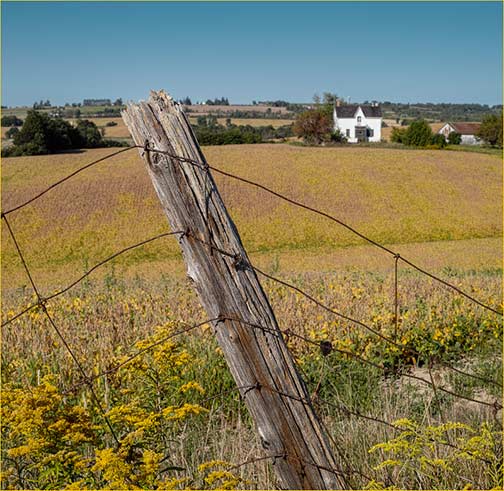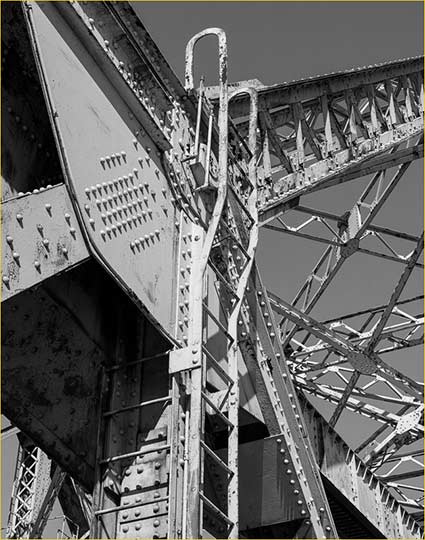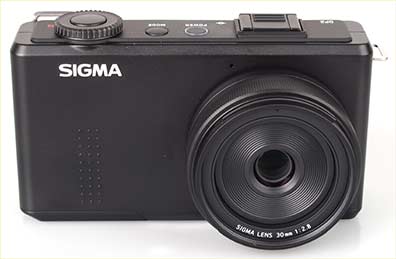
Life used to be simple. If you wanted top image quality you got a big camera with a large sensor (or large film size). If you wanted a camera that could shoot high speed bursts you bought an SLR or DSLR with motor drive. If you wanted small size and light weight you bought a pocket-sized camera and accepted the compromise that a small sensor had to offer.
But the world is ever changing. Inexpensive pocket cameras are a dying breed. Smartphones now are the camera of choice for most people, and camera makers are seeing their sales in this catagory drop by 25% or more each year. DSLRs used to be the high speed shooting king, but now compact system cameras without mirrors and with electronic shutters are capable of sustained burst rates far higher than anything seen before, and certainly at more affordable prices than the big guns.
Medium format backs and cameras used to be where one went for ultimate image quality, especially for high pixel count and wide dynamic range. But the 36 Megapixel Nikon D800 and D800e have thrown that equation into a cocked hat, and now there are rumours of a 46 Megapixel Canon later this year or early next (these rumours are likely true). Yet there are still markets for all types of equipment, because photographers have a wide range of needs and budgets. But the equipment marketplace is much more homogenious than it was even just a year ago, and it’s going to get more so even more quickly in the months ahead.
Goldenrod Fence. Clearview, Ontario. September, 2012
Sigma DP2 Merrill @ ISO 100
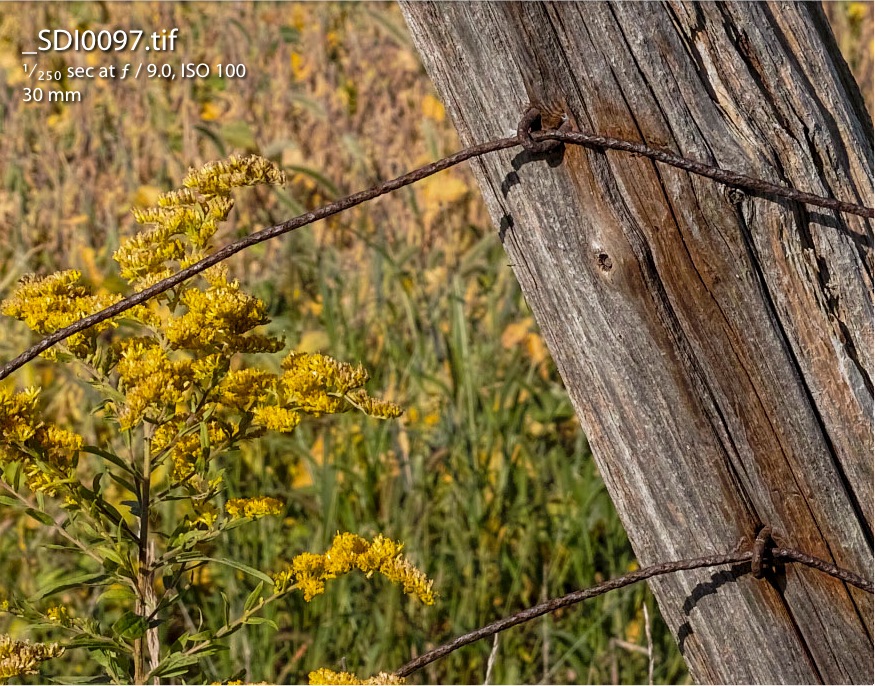
The DP2 Merrill
If you want the full specs, check out Sigma’s mini-sitewith all the details. In brief, this is a small, dense, coat pocket sized camera, with an APS-C-sized sensor; a 46MP X3 Foveon type. It has a fixed 30mm f/2.8 lens, which provides coverage equal to a 45mm lens in full frame terms.
The nameMerrillis an homage toDick Merrillone of the founders and inventors of Foveon technology.
Let me be clear up front, though I’ll have more to write about this further in this report. This is anything but your typical large sensor pocket camera. It fails badly against the competition in some respects but blows them away in others. Also, anyone looking for a pocket camera for taking pictures at the kids birthday party should definately look elsewhere. This is the wrong tool for that job.
So, without further ado, and in no particular order, here is what’s wrong and what’s right with the DP2M.
What’s Missing
– no stabilization
– no built in flash
– no scene or art modes
– no available EVF
– no zoom
– no LCD articulation
– poor to zero availability of important accessories, such as extra batteries and lens shades
What’s Wrong
– stumbling autofocus in low light
– slow buffer writes, even with fast cards. No further image review till buffer is empty
– only VGA quality video
– slowish lens
– very poor battery life (two batteries are provided)
– high-res bright but laggy (wobbly) rear live view LCD
– poor image quality above ISO 400
– occasional banding when colour values are pushed hard in B&W rendition, such as blue skies
– poorly designed raw software, with no superior alternatives currently available, or likely to come
– occasional strange colour reproduction, colour transitions – especially around reds, and blotchyness. Not sure if this is the sensor or the SPP software
– manual focus only works as an adjunct to AF with a half shutter press. It is locked out when AF lock is activated
– Auto-ISO won’t use ISO 100, even in the brightest situations. Maybe this is to compensate for the camera not having stabilization
– my camera has two dust spots on the sensor, unforgivable in an non-interchangable lens camera with a non-retracting lens
What’s Right
– a world-class lens, perfectly matched to the camera’s sensor
– spectacular sensor resolution. Nothing like it on the market for the money or even anywhere close to the money
– a unique image “look”; hard to describe but recognisable, and part of what some people call the X3 sensor’s “3D look”
– good manual focus assist with on-screen magnification, but alas no “peaking”
– 7 frame buffer, but slow to empty
Some people have described the AF as a bit slow. It’s not. If it can lock onto something it’s there in a moment, and I always find it to be dead accurate. The problem is that in low light and low contrast situations it hunts, and sometimes can’t find a lock. Just not on a par with other contemporary contrast detection systems. Manual focus is always an option.
There is a nicely implemented AF/MF mode where with the focus locked by a half-press of the shutter release, while the ring around the lens provides magnified manual focus. Nicely done, and potentially reassuring that the point being focused on is in the fact where you expected it to be.
The build quality, general design and “feel” of the DP2M is excellent. It’s a brick of a camera; hefty, though not too heavy. There’s little by way of ergonomic concessions (grips and such), but it still falls to hand nicely. It’s hard to describe, but there’s a tactile “rightness” to the DP2M that eludes many other cameras, and its clean appearance says that this is a camera with a purpose, not a generalized tool. Nevertheless, a third-party finger grip would be welcome, and I know that there is at least one on the way. It will be reported on here when I get an opportunity to try it.
As noted, there are no scene modes or art effects. This is not a camera intended for amateurs or dilettantes.
Lift Bridge. Toronto. August, 2012
Sigma DP2M @ ISO 200
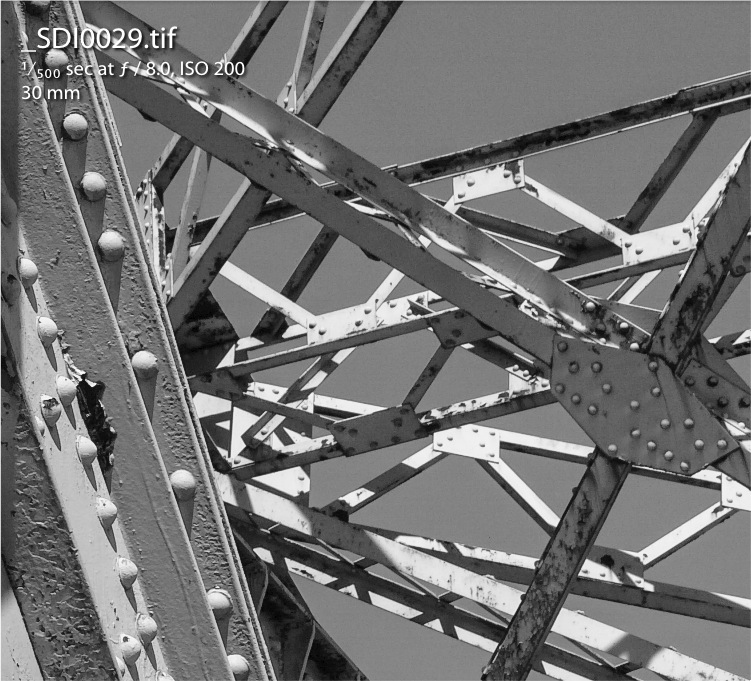
100% on-screen crop
The DP1 Merrill
The DP2 Merrill has a sister, theDP1 Merrill, which is essentially an identical camera but with a 19mm f/2.8 lens (28mm equiv) instead of the DP2M’s 30mm f/2.8 (45mm equiv). It will be available in mid-September, 2012, for the same price as the DP2M, USD $1,000. Assuming that the lens is as spectacular as that on the DP2M the choice between the two models will simply come down a personal preference between medium wide and so-called normal focal length use. Maybe you’ll want both?
What About the SD1 Merrill?
The DP2M has the same sensor and image processing as does the SD1M. The new Merrill version of both cameras is in fact much better IQ-wise thatthe one that I reviewedback in July 2011, just a bit over a year ago.
With a year’s hindsight I think it fair to say that the launch of the SD1 was one of the worst marketing failures in the modern history of camera makers. Announced in May, 2011 at USD $9,700 the market responded with incredulity, dismay, and most importantly by keeping their wallets closed. The actual retail price soon dropped to around $8,000 then continued to drop as the year advanced. Finally the senior corporate management in-fighting that lead to this pricing debacle came to an end and the camera settled at something around $3,000.
But the problem was that by that time other players had had time to launch cameras like the Nikon D800/E and new Canon 5D MKIII, just to name a couple in the $3,000 price range. Now (August, 2012) with a current promotion on the new SD1 Merrill is priced at $1,999. This is the price that it should have been over a year ago. The truth is that excepting image quality the SD1 is a mid-level camera. In terms of built quality and features it isn’t anywhere near what a high-end Nikon or Canon is, and it never was. Only Sigma’s corporate management’s hubris thought that it was. But now, the cat’s out of the bag, and the market is full of strong competitors, not just in terms of built quality and features, but also general image quality.
I imagine that at under $2,000 there will still be some who’ll find the SD1M attractive. But, the reason for this brief history tour is to point out that anyone looking for the very appealing image quality of the SD1 ((nearly $10,000 just over a year ago) can have it, along with important improvements)) in the DP2M today for under $1,000. No, the DP2M is not a DSLR; no it does not take interchangable lenses; but if contemporary X3 image quality is what you think might turn your crank then the DP2M may be right up your alley.
Foveon X3
Sigma cameras using Foveon X3 technology sensors are highly controversial. There is likely no single technology that causes more heated debates, either on-line or whenever a group of photographers gather, than the issue of colour matrix versus direct colour technology.
I have written about Sigma / Foveon sensor cameras before, in my originalDP1 review,my SD1 Announcement,SD1 Review, and in an SD1 Pricing discussion. I won’t repeat all of the pros and con arguments and technical discussions, other than the couple of paragraphs below which are for the total Foveon neophite.
Direct Colour vs. Colour Filter Array
Other than sensors that use Foveon X3 technology all sensors (CCD and CMOS) use what is called a Bayer Matrix so as to be able to reproduce colour. Silicon photo sites are not able to record colour directly, and so various Filter Array technogies have been developed to make this possible. A Bayer matrix is by far the most common, and is used in virtually every camera on the market, from the smallest point-and-shoot to the largest medium format backs.
A Foveon sensor stacks R, G and B sensitive photosites vertically instead of horizontally. The advantages are that no colour array is needed, and this means that there is no colour aliasing. No colour aliasing means no need for a blurring filter (AA filter), and thus higher apparent resolution. And, though we are all used to counting the total number of photo sites in a Bayer sensor as contributing to spatial resolution, they don’t. It’s just that this is what we’re used to.
Doing the Numbers
 |
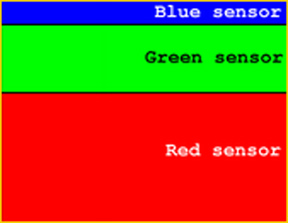 |
|
Bayer Filter Array |
Foveon X3 |
Over the years, since Sigma started championing (and now owning) the Foveon X3 technology, the world has had a problem with the way in which each sensor’s megapixel count is stated. It is an understandable problem because in a Bayer sensor there may be, say, 20 million photosites but not all of them are used for luminance information. There are two greens for every red and blue combination and only the greens bare primary responsability for spacial resolution. The reds and blues are primarily for colour information. But, in an X3 sensors the sensors are stacked vertically and so each one contributes to luminance as well as colour information. So, take the new Sigma DP2M. It has a 46 Megapixel sensor according to Sigma. But since two thirds of these lie in the same spacial position as the other third there is no actual net grain in spacial resolution.
It’s complicated though. A Bayer sensor doesn’t record as much spacial resolution as its basic pixel count (say, 20MP) would indicate. It’s actually about a third less than this, but since virtually every other sensor in every other camera on the market suffers the same handicap, no one fusses about it. It’s a level playing field; well almost, if its weren’t for Foveon and Sigma’s X3.
Sigma made things problematic until recently by claiming that their sensor was 46 Megapixels. Yes, it is, but not when compared to a Bayer. With this new generation of cameras though Sigma needs to be given credit for, for the first time in their promotional literature, instead of just boldly stating 46MP, the say that this sensor isequivalentto a 30 Megapixel Bayer. While this is still a push, it’s a lot closer to the truth.
The problem also comes in the Sigma X3 cameras do not have anti-aliasing filters. They don’t need them because there is no colour aliasing because there is no Bayer matrix. This gives an X3 sensor a clear resolution advantage over any Bayer camera that does have an AA filter. Of course there are some Bayer cameras that don’t have AA filters either, such as the Leica M9, S2, Nikon D800e and others, and so as you can see it isn’t a simple discussion.
In the end this also isn’t a discussion that I particularly care much about. It still riles up the debaters on net forums, but those are about the only ones still paying attention. Most serious photographers that I know are much more interested in a sensor / camera’s real-world performance than just its megpixelage, because they know that there is a lot more to image quality than just numbers. In any event, once camera got above about 11 Megapixels only a relatively few photographers who make extremely large exhibition prints really cared any more. Yes, 40, 60 even 80MP is nice to have, but it’s a sensor’s other imaging qualities that make the real difference when it comes to IQ.
So, Sigma calls the DP2M a 46 Megapixel sensor but then qualifies it in the small print and says that it’s roughly equivalent to a 30 Megapixel Bayer equipped sensor. The actual spacial resolution is 15 Megapixels (not at all shabby in its own right in an APS-C sized sensor). If I had to pick a number I would judge the DP2M to be roughly equivalent to about a 24–28 MP Bayer camera. But, as I wrote, this is the stuff of web forum fights, not something that serious photographers really spend that much time fussing about.
Compared To
Here are a series of unscientific, seat-of-the-pants resolution and sharpness comparisons with a few cameras that I have on hand and which might be regarded as competative with the new Sigma in various ways. I tried to match image size as closely as I could, but when you figure that focal lengths didn’t match, sensor size often didn’t match, and resolution also didn’t match, it’s a wonder that I have the guts to publish this at all.
When it came to exposure the choice were expose to the right, expose indentically, or expose as metered by the camera. I decided to do the latter since this is most representative of real world use. (I can hear the complaints and requests now… can you shot this one or that one again, with X, or Y, or Z variable different? The answer is NO. I won’t. Life is too short (literally), and the tests that I did satisfied me as to the results. You want ’em, you do ’em).
In each case I am confident that the results shown are fairly representative, and in several cases I did additional tests just to confirm that I wasn’t dealing with single situation errors. Disagree? Fine, when you do your own comparisons, send then to me, and if they differ in any sustantive way from mine I promise to pubish them.
Please note:Sigma DP2 files here have not been sharpened, because they don’t need any. In camera and in SPP sharpening settings were both 0.
Sometimes I find I have to dial in some negative sharpness for certain image. All other cameras used have had their files shapened to taste in Lightroom 4.
Sony RX100

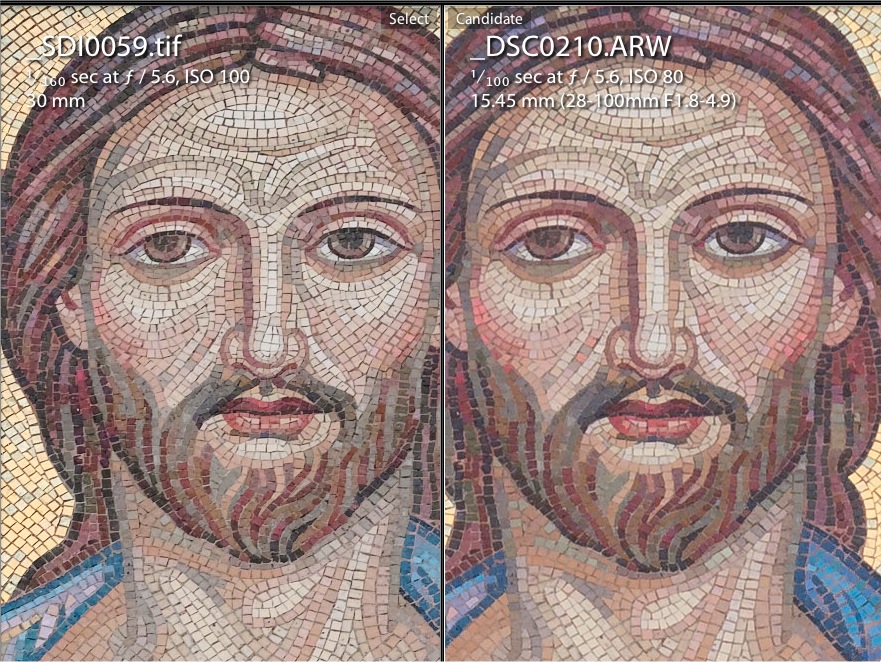
Sigma DP2M ––––––––––––––––––––––––– Sony RX100
One of the most popular, if notTHEmost popular and highly rated new pocket cameras is the 20 Megapixel Sony RX100. I raved about it in my review, as did most every other reviewer. Above are 100% crops. The Sony was zoomed to an equivalent focal length and settings otherwise matched as closely as possible. Both images have been optimized in either SPP, or LR4, or both. White balance was set on the same white square in the mosaic’s right eye and levels were adjusted to match over all brightness.
Leica M9

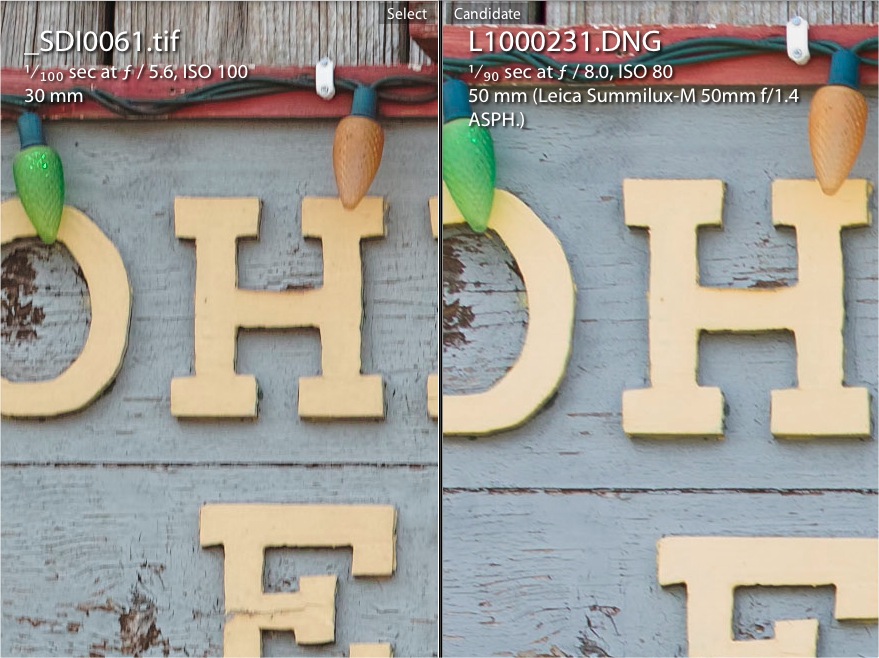
Sigma DP2M ––––––––––––––––––––––––– Leica M9 with 50mm Summilux
This comparison presented some difficulties. Even though I’ve been a Leica M user for about 35 years, and I used an eyepiece magnifier, I found that my focuses weren’t always perfect. That’s why this sample was at f/8, rather than f/5.6 like the others. There was a focus problem with the one at f/5.6. Not a big deal, me thinks. Of course there is a magnification difference, due to the Summilux being a 50mm and the Sigma an effective 45mm. I would have gotten them closer in size by physically moving, but there was sun creaping over the top of the building and when I did it caused flare. Such are the perils of real-world testing. Again, the only adjustments were to match white balance and exposure and some appropriate sharpening on the M9 file.
It seems to me that the DP2M has a resolution edge over the M9 and 50mm Summicron. Not huge, to be sure, but visible. It certainly has a price advantage, about 10:1 – literally an order of magnitude, but it’s a fixed lens rather than interchangeable, and its not a rangefinder, etc, etc. I know that these comparisons are flawed, but they’re fun and informative. Just keep your sense of humour.
Sony NEX7

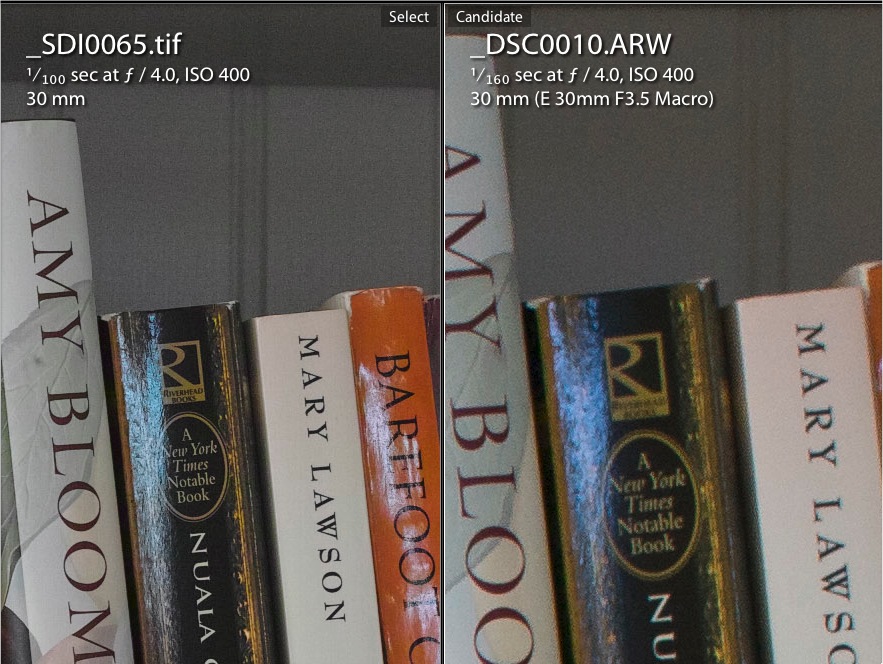
Sigma DP2M ––––––––––––––––––––––––– Sony NEX-7 with 30mm f/3.5 Macro
The NEX-7 is one of my favourite new cameras. I’ve shot more than 8,000 frames with it over the past 10 months. It’s 24MP APS-C sized sensor is now being used (or soon will be) in a number of cameras from other companies.
The 30mm Macro lens isn’t necessarily my favourite, but I didn’t want to use a zoom, and it was the closest focal length I had available to try and match the Sigma. It’s not a highly rated lens byPhotozonefor various reasons, but they do write “The center image quality is absolutely great“.
In any event, some confirming shots with a couple of zooms showed the resolution superiority of the DP2M to be the case regardless of the lens used.
Fuji X-100

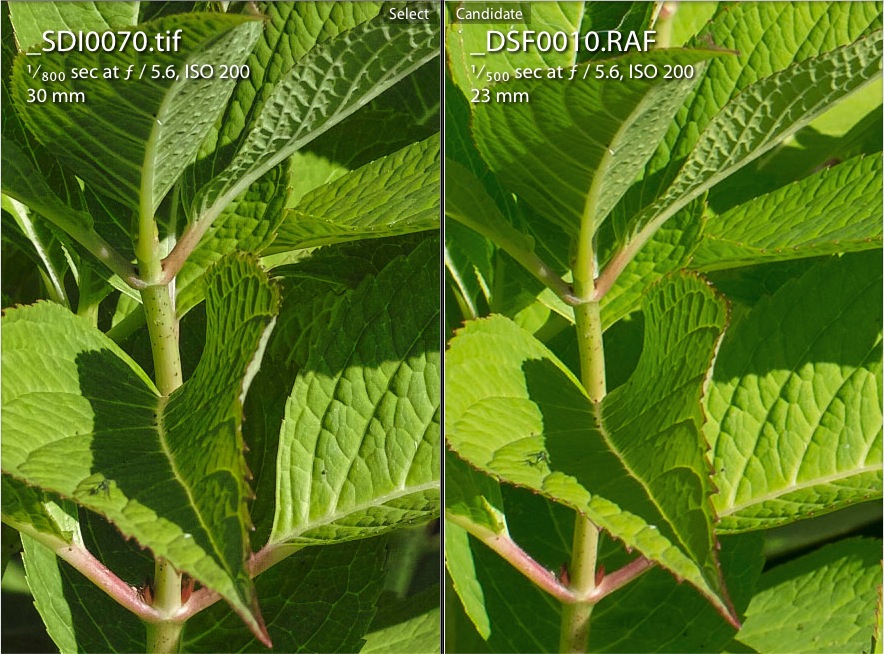
Sigma DP2M ––––––––––––––––––––––––– Fuji X-100
For all its flaws and foibles I have never been unhappy with the image quality of the Fuji X100. It’s really terrific. But then I did this comparison with the DP2M. What more is there to say?
Colour Accuracy
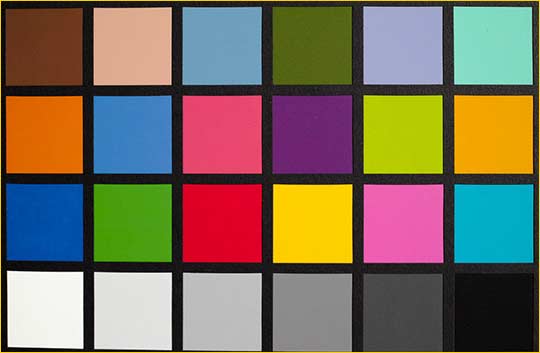
Sigma DP2 Merrill Macbeth Colour Chart. Standard Mode.
White Balanced to Square 21(bottom row, third from left)
Much has been made over the years over the colour accuracy of the Foveon sensor. I mentioned this again in my SD1 review last year. Sometimes the colours were simplyfunky, for lack of a better description. This seems to have been addressed in the Merrill versions of the camera, the SD1M, DP2M and DP1M, if my experience with the DP2M is anything to go by. This is the case at ISO 100 and ISO 200, but colours start to shift at above 400, and by 1600 colour is a mess. This is simply a low ISO camera, but we already knew that, didn’t we?
What I have noticed is a tendency toward cyan skies. This is easy to correct in post, but something to watch for. Also deep shadows can sometimes take on a magenta cast or blotchness. This is only at extreme pixel peeping though and unlikely to be an issue in prints.
ISO 400
ISO 100 and 200 are typically very clean. ISO 400 a bit less so, but not so that you’d even need to crank up any noise reduction in post. Above 400 starts to get iffy, and to my mind this just isn’t a camera for which high ISO work is its forte.
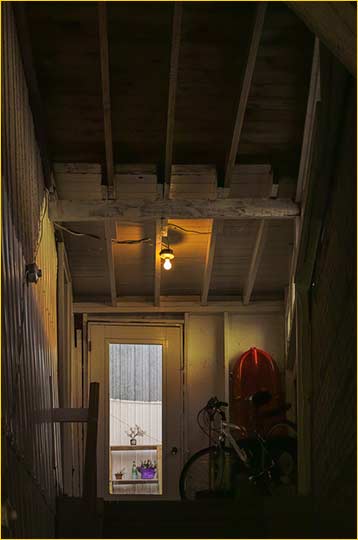
ISO 400. About 50% of the total frame, as shot
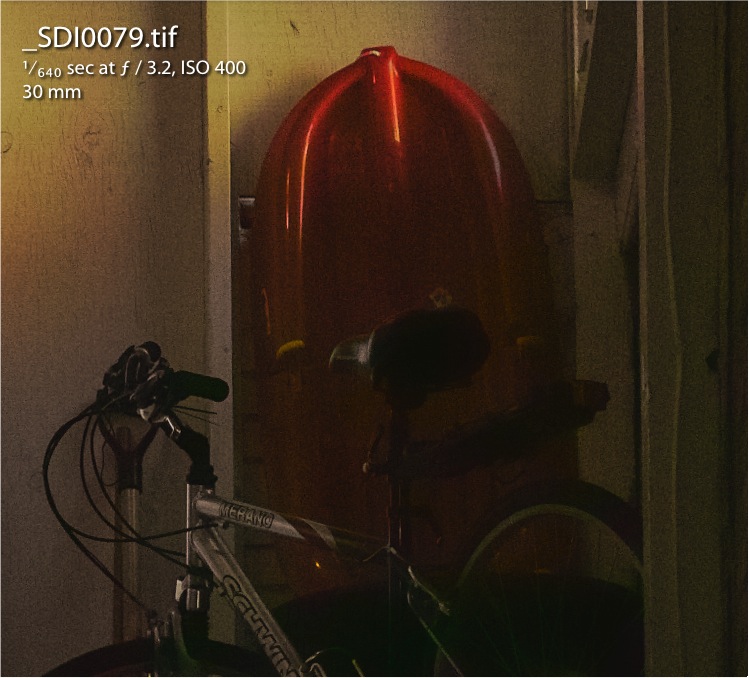
Crop of above at 100% on screen
Shadows are clean, and unless one really pushes them open to an extreme degree there is no visible banding at 100, 200 or 400.
Battery Life
The battery life of the DP2M is poor; somewhere between 75 and 125 images. The reason for this is two-fold. The battery is small and the power drain from the X3 sensor along with dual custom processors is high. The answer would have been a larger battery. The camera is already about as large as it wants to be, and it’s my surmise that this is where Sigma’s engineers had to compromise. To Sigma’s credit, they include two batteries with the camera, an industry first if I’m not mistaken.
Regratably Sigma, like so many companies, does not consider its customers needs when it comes to accessories right after launch. There do not appear to be any Sigma BP-41 batteries available anywhere in North America. Fortunately the Ricoh DB-65 is said to be the identical battery. Be aware that non-Ricoh brand generics may not fit without some surgery with an X-actro knife.
Lens Shade
Ialwaysuse a lens shade. Always! There is no point in having a great lens and then ruining contrast with flare. But as with the Sigma batteries Sigma North America must have dropped the lens shades off the side of the boat because there are none to be had. I bought mine out of Japan on e-Bay. It’s the LH2-01.
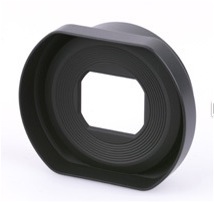
Raw Files and Processing
The SD2M can shoot raws, JPGs, and raw plus JPGs. Since, as well soon see, this is not a camera for amateurs, or actually anyone with less than the need for exceptional image quality and knowledge of how to achieve it, I can’t see much use in shooting jpgs. They are pretty good, but raws are much better in terms of IQ with this camera. I would avoid JPGs here, as with any camera for serious work, because a JPG has baked in white balance, and the DP1M’s white balance can a bit funky at times. By shooting raw you’re able to simply leave the camera set to Auto White Balance and then adjust it in post if necessary.
As well, a JPG is only an 8 bit file in sRBG, or at best Adobe RGB, while a raw is in a huge native colour space and can be exported to a 16 bit TIFF in Prophoto RGB, retaining just about all the quality that one could wish.
This brings us toSigma’s Photo Prosoftware,Version 5.3provided with my camera. While not as truely horrible as Silkypix, used by some other camera makers, SPP is slow and not that straightforward to use. It doesn’t take long to figure out (there is an online HELP, but no comprehensive user manual), so you’re kind of on your own in any event. But, it’s not a place that you want to spend much time.
My Workflow
What I do with DP2M files is copy them from the memory card to a directory calledDP2M RAWSon my working drive. I then run SPP and point it at this directory. When I see a file I want to process I double click on it to load it into the processing module.
Beforehand I also set up Preferences in SPP to save converted raw files to a specific directory on that same drive named Converted DP2M TIFFs.I set the output to 16 bit TIFF in Prophoto RBG. My preferred image processing program is Adobe Lightroom which I similarly preset with a “Watched Folder“, which as you might have guessed I name Converted DP2M TIFFs. Then, whenever I press Export in SPP a 16 bit TIFF opens automatically in Lightroom ready for further processing.
As for what I do in SPP, the answer is, as little as possible. I find just about every tool in SPP inferior to those in Lightroom (or Capture One or Aperture for that matter). The only thing that really matters, and that one that onemustdo in SPP is white balance. I then may do some other minor adjustments, but if the file is properly exposed, I just adjust white balance and then Export the file to Lightroom.
Now, you may ask, when can we expect Adobe to support DP2M files, the way some previous X3 files have been? I can’t answer the question directly, but I can tell you that responsibility for making this possible appears to absolutely lie with Sigma.
Sharpening
The sensor in the DP2 Merrill is scary in its resolving power. To their immense credit Sigma has married it with a lens that is similar outstanding in its resolving power. The two together present a file that has to be seen to be believed, and which punches well above its weight when it comes to print enlargability. Beautifully clean and crisp 20X24″ prints are no problem, and likely larger ones, though I have not yet made any.
With in-camera sharpening set to 0 and similarly in SPP, I find that most files show very high but usually appropriate sharpness (edge contrast). I will sometimes dial it down a notch in SPP, but I’ve never found a need to increase sharpening in Lightroom.
Definately Not for Camera Pussys
Before anyone gets their panties in a twist over the perceived use of an obscenity, let’s define terms. I am definitely not referring to the notorious Russian rock group Pussy Riot. Those are another type of pussy.
puss·y: Slang – A man regarded as weak, timid, or unmanly.
So, why do I write that the DP2M is not for pussies? Because in my photographic-context definition, acamera pussyis someone that is not confident about their photography. They believe that if only they had theright camera, their photography would improve. Better composition along with better technical execution would also ensue. Magical thinking.
Thecamera hero(the opposite of the camera pussy) on the other hand knows what kind of camera they need for the type of shooting that they do. They regard looking at spec sheets and comparing camera statistics as an onanistic pursuit. What counts is, does the tool come to hand (no puns intended) in an appropriate manner to get the desired task accomplished.
The best analogies are cars. One might lust after a Ferrari, but if hauling the little league team to the ice rink every morning is the required task, a mini-van is the more appropriate tool.
In the context of the DP2 Merrill the only photographers who are going to be happy with this camera are ones who can ignore its few faults and rejoice in the remarkable image quality that the camera is capable of. To get the most from the DP2M will require not just patience (hesitant AF, slow buffer writes, lousy raw software, wobbly screen image, etc) but the willingness to put these aside in exchange for what is delivered – the highest image quality from any camera this side of a 36MP+ DSLR or Medium format camera or back. No mincing words. That’s what I see.
Have I compared the DP2M to a Nikon D800e or a Phase One IQ180? The much higher resolution of both of these devices skews the results as you might expect, and of course the DP2M is a fixed lens pocket camera not a DSLR or MF back, so enough said about those particular comparisons; but if you saw them you’d be suprised.
What we’re left with is a high quality pocketable 15MP camera that punches well above its weight; more like a 26MP camera in terms of image quality. It has some operational annoyances, but if you can get past them the overall excellence of the images that the Sigma DP2 Merrill produces will amaze and satisfy even the fussiest photographer. Sigma has finally taken Foveon technology to its long-anticipated potential, and naming this generation of cameras after inventor and founder Richard Merrill is most appropriate. Somewhere, Dick is likely smiling.
Please note that the Sigma DP2 Merrill reviewed here was purchased at retail, as are most of the camera which we review. We have no relationship with Sigma and they are not an advertiser on this site.
September, 2012
UPDATE – Sept, 13, 2012
New firmware for the DP2M and an SPP software update has become available.
http://www.sigma-dp.com/download/dp2m-firmware.html
You May Also Enjoy...
Bolt From The Blue
Please use your browser's BACK button to return to the page that brought you here.
